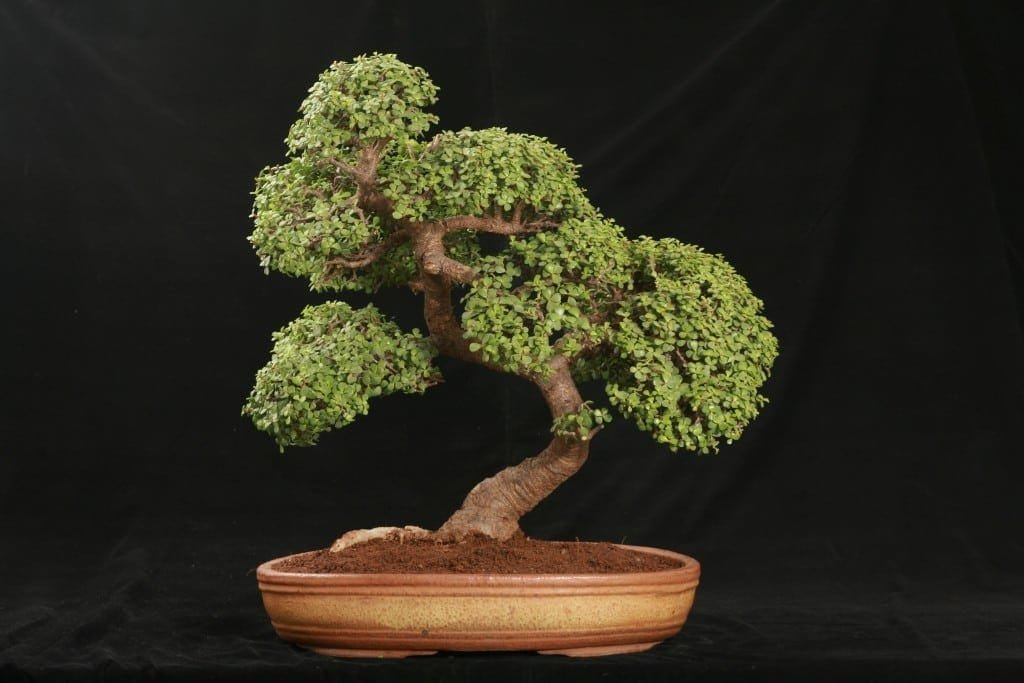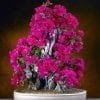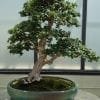The jade tree plant, or Crassula ovata, is native to the Capetown area of South Africa. The jade tree plant is part of a plant classification known as succulents. The jade plant has thick, glossy, deep green, oval shaped leaves and thick, brown stems.
Succulents typically grow in dry areas such as deserts and its leaves hold water for long periods of time. The jade plant prefers coarse, sandy soil similar to the soils found in its natural desert habitat. Because of this, jade plants are good plants for the novice horticulturalist because it’s very low maintenance.
Most people are not aware that the jade plant produces pink-tipped, white blossoms with a delicate star shape. This is because the plant will not bloom when it is kept indoors. The plant blossoms in the winter because of the lack of natural daylight.
If the plant is kept inside where lights are turned on and off, it is unable to sense this change in the amount of daylight, which is what triggers blossoming. Experts recommend that to get this plant to blossom, it needs to be exposed to full daylight outside beginning in the autumn.
| Scientific/Botanical Name | Crassula ovata |
| Description | The jade tree belongs to the succulent class of plants. The trees oval-shaped leaves are fleshy and deep green in color. The brown stems are rather thick. Succulents usually grow in arid environments such as deserts, and their leaves are adapted to retain water for extended periods. |
| Position | Jade plants grow successfully in light conditions ranging from full sun to part-shade, and a daytime temperate range between 70o and 75o Fahrenheit. They prefer nighttime temperatures that hover around 50o and 55o Fahrenheit. Jade plants are adapted to dry climates, and may be safely planted outside where such conditions exist. |
| Watering | Less is more as far as watering jade plants is concerned. The fleshy leaves conserve water so allow extended periods between watering. Depending on ambient conditions, a watering schedule could be once every 10 days or once every 20 days. It is typically once every 30 days in the winter. |
| Feeding | No information is available. |
| Leaf and Branch Pruning | Spring and summer are the best times for pruning jade trees. This is when the plant is undergoing the most active growth, and the plant will heal faster after pruning. Using clean, sharp implements, Cut away heavy and/or awkward branches by clipping right above the node. The point where one branch grows out from another branch is known as the node. |
| Re-potting & Growing Medium | Jade trees grow slowly, and keeping the jade plant in a small pot will maintain a dwarf size. If a larger size plant is desired, the tree should be re-potted into a larger container. |
| Wiring | Jade plants take quickly and easily to wiring. Wires may be used to train jade plants into various styles, and within one month the new position will become set. |
| Notes | When it is grown outdoors, the jade tree produces star-shaped white blooms that have pink tips, but the plant does not bloom when it is grown indoors. The well-lit conditions that typically exist indoors are known to interfere with the mechanism by which the plant detects a reduction of light in wintertime — and the plant must detect reduced light so as to trigger the production of blossoms. Mealy bugs may attack jade plants. If this happens, use a cotton swab that is saturated with rubbing alcohol to treat the section of the plant that is affected. Aphids can damage jade plants and cause the development of fungal growth. A natural predator of aphids is the ladybird beetle, and the beetles may be introduced to control aphid infestation. Failing that, an aphid-specific insecticide can be used to treat the plant. |
Care And Feeding Of The Jade Tree
Jade plants do not need much watering. The optimum watering cycle in the summer is around ten to twenty days between watering. In the winter, the cycle extends to around thirty days. Overwatering can lead to limb breakage. Jade plants grow best in full sunlight to partial shade.
The ideal temperature should be around 70-75 degrees during the day and 50-55 degrees at night. Jade plants can be planted outside in dry climates. Jade plants are sometimes used as hedges in warmer, drier climates. If the jade tree plant is going to be planted outside, plant them about twenty-four to thirty-six inches apart.
Like other plants, jade plants need pruning. Pruning should be done during the Spring and Summer. This is the plant’s active growing season. The plant will heal faster when pruning is done at this time. Always use sharp tools to prune the plant.
Sharp tools will make clean cuts. Jagged cuts and dirty or dull tools will harm the plant. Choose the branches that appear to be out of place or heavy. Always clip above the node. The node is the point on a plant where one branch grows from another.
These clippings can be replanted or propagated. It is recommended to allow the stem ends to dry out first. A couple of weeks are sufficient for this to happen. Once the end is dry, pot the stem cutting in dry soil. After about two more weeks, the cutting can be watered.
Jade plants can also be propagated by its leaves. Simply put the stem end of the leaf into soil and soon the leaf will produce roots, which will take root into the soil.
Pests Common To The Jade Tree
The jade plant is susceptible to mealy bugs, which is a pest that has a white and foamy appearance. These pests are easily removed by treating the affected area of the plant with a cotton swab dipped in rubbing alcohol.
Aphids are another pest to contend with. Aphids cause damage to jade plants by sucking the sap from the leaves. As they feed, the aphid injects its saliva into the plant. Aphids also secrete a thick liquid known as “honeydew”. This liquid coats the leaves, which then take on a sticky appearance.
This sticky liquid, in turn, attracts other pests such as ants and wasps. Honeydew also promotes fungus growth. Lady bird beetles are one natural parasite that helps to control aphids around plants. If natural parasites are not enough to get rid of the aphids, then an insecticide or other remedy can be used to rid the plant of these insects.
Jade Tree Plants As Bonsai
Jade plants are slow growing plants. Most people choose to keep them as houseplants by keeping them in smaller pots, which dwarfs the plant. Jade plants, if left to grow, can grow as high as ten feet tall. If someone wants their jade plant to grow bigger, they only need to replant it in a larger pot.
The ideal dimensions for a jade bonsai tree is seven inches tall by seven inches wide, which is easily achieved by planting in the right sized pot. Because of this characteristic, the jade plant is often an excellent choice as a small ornamental tree.
Another characteristic that makes the jade plant a good choice as bonsai is that the plant can be trained to grow in another direction. Simply use stakes and wires or strings to change the position of the plant. In about a month, the plant will take to the new direction.
Because of their low maintenance, jade tree plants make excellent houseplants. Jade tree plants are a good option as bonsai because the plant only grows as big as the pot in which it is planted. Jade tree plants are found at your local greenhouse or garden center.


